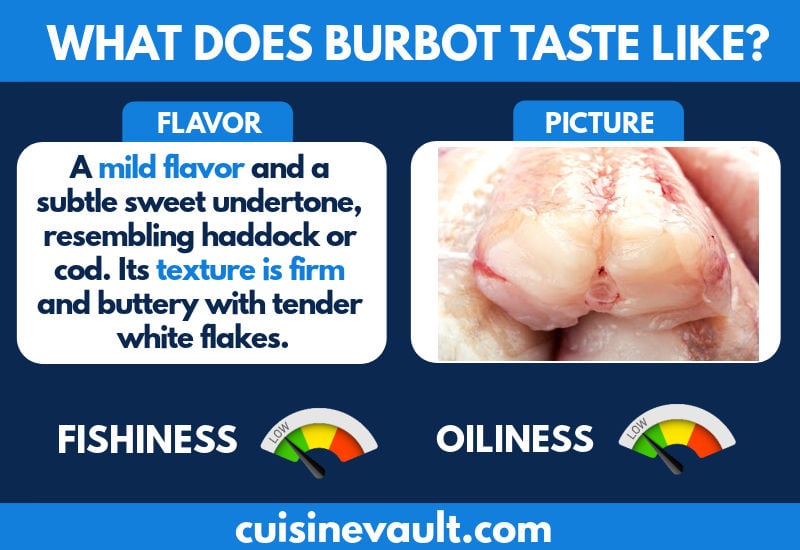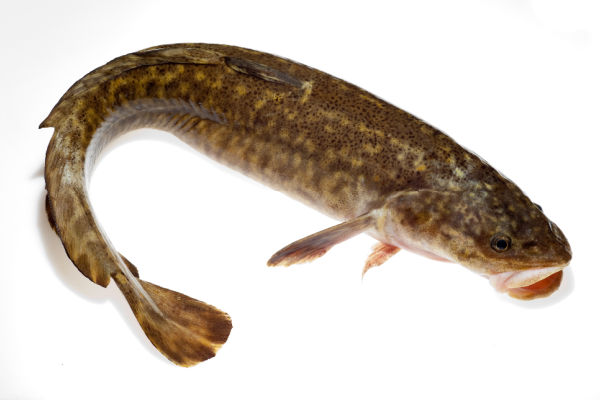Burbot is a freshwater fish that is commonly found in lakes and streams in Europe and North America. It is closely related to the ling and is well known in the fishing community for being one of the more ugly fish on offer. Looking like the love child of an eel and a catfish, this fascinating creature can easily be identified by its single barbel protruding from its chin.
Would you like to know what burbot tastes like? We’re about to give you all the details so that you know if it’s worth ordering on the menu or trying to catch next time you go fishing.
How does burbot taste?
The burbot is a white fish with a mild flavor and a subtle sweet undertone, resembling haddock or cod. Its texture is firm and buttery with tender white flakes. Burbots don’t have any bones, which makes eating them easier and more enjoyable. It is an excellent fish for kids thanks to its combination of mild flavor and boneless meat.
Burbot is often referred to as “poor man’s lobster” and is excellent boiled or steamed. Some believe it has a similar taste to American lobster. The fish can be cut into large chunks and served alongside melted butter, which acts as a delicious dipping sauce.
 The back straps are considered the “choicest” part of the fish, prized for their flakey texture. However, the belly meat is also moist and tender and is well worth keeping if you’re filleting the fish yourself.
The back straps are considered the “choicest” part of the fish, prized for their flakey texture. However, the belly meat is also moist and tender and is well worth keeping if you’re filleting the fish yourself.
In some parts of Europe, particularly Finland, the liver and roe of the burbot are sought-after delicacies. The fish's liver is unique, growing up to six times larger than other similar-sized freshwater fish.
Summary of the burbot’s flavor
| Feature | Description |
|---|---|
| Flavor | Mild |
| Texture | Firm |
| Fishiness | Low |
| Oiliness | Low |
| Color (cooked) | White |
Recommended flavor pairings
We recommend cooking this subtle-tasting fish with other ingredients that won’t overwhelm the fish’s flavor. A sprinkling of salt and pepper combined with a squeeze of lemon juice is simple but delicious.
- onion
- garlic
- lemon
- dill
- paprika
- cajun seasoning
- parsley
- salt
- pepper
Side dishes
Restaurants often serve burbot fried in batter with a side of fries. It’s moist white texture and lack of bones make it perfect for this meal. The fish is also enjoyable served with melted butter for dipping.
- melted butter
- hot chips
- steamed vegetables
- garden salad
- rice
- cabbage rolls
- baked potatoes
Poor man’s lobster recipe
Burbot is an excellent fish for poaching. Timing is the secret to perfectly cooked, tender meat. Once the fish has boiled for two minutes, work quickly to remove it from the heat. This will help avoid tough, rubbery flesh.
Ingredients
- 1 pound burbot backstraps
- 1 quart water
- 3 tsp salt
- ¼ cup vinegar
- salt and pepper, to taste
Method
- Place the fish on a chopping board and slice into thick cubes, suitable for bite-sized pieces.
- Add water to a saucepan and stir in the salt. Heat on a high temperature until boiling.
- Pour vinegar into the water and wait for it to boil before carefully adding the fish with tongs. Once the fish has boiled for two minutes, remove from the water immediately and drain. Season with salt and pepper.
- Serve on a plate with an accompanying bowl of melted butter.
Notes:
- We recommend using the backstraps as they are the best part of the fish.
- Always eat burbot freshly caught if possible as it offers the best taste and texture. Once frozen the fish becomes rubbery and unpleasant.
The easy way to clean
The leathery skin of a burbot can be pulled off the same way you would a catfish. On the first attempt, many find this easier said than done! To make life easier, bang a nail into a pole or somewhere suitable to hang the fish from its head. Carefully cut the skin around the fish, at a point near its neck. Next, use a pair of sturdy pliers to peel the skin down, and off the fish. Once the skin is removed, the burbot can be cooked as it is or it can be filleted.

A freshly caught burbot ready to clean.
Fast facts about burbot
- other names include lingcod, cusk, coney-fish, bubbot, eelpout, the lawyer, and freshwater ling. Source.
- For many years during winter, Walker, MN held an annual ice fishing contest on Leech Lake which is called the International Eelpot Festival. Unfortunately, they have had to cancel the event due to increasing County requirements.
- in Siberia, the robust skin was historically used as a replacement for glass in windows.
- the fish lives under the ice for part of the year - cold waters are required for the burbot to spawn effectively.
- they spend much of their time deep underwater and can live for up to 20 years.
- burbot is suitable for poaching, frying, or baking.
Related reading:
What are the best lobster substitutes?
Summing up
The burbot isn’t always talked about by recreational anglers in a positive light. Jump onto a recreational fishing chat group and you’ll find pages littered with unfavorable comments. This will often puzzle commercial fishermen who consider it a great fish for eating. At a glance, it seems that much of the negative discussion centers on the burbot’s ugly appearance; but once cooked, the fillets look mouth-watering on the plate. Others complain about the texture; this is mostly the result of overcooking the fish, or not eating the back straps.
When cooked well, burbot has a lovely mild flavor and a subtle sweet undertone. Its boneless meat has a firm texture that is buttery and tender. This is a fish that you may want to serve to fussy eaters and people who prefer mild-tasting fish – just don’t let them see what the fish looks like before it has been filleted!
Have you tasted burbot? What did you think of its flavor? Please drop us a comment below.

Leave a Reply